Earlier this week we ran a Storybuilding Pop-Up to coincide with Family Literacy Day. Thank you to all the wonderful families who came out to celebrate literacy with us! It was amazing to see so many children deeply engrossed in the process of story-building. They created intricate tales about birds and thieves, wildlife photographers, safaris, zoos, butterfly gardens and even cities that are endangering animal habitats!
| As we began looking through the images from the event, we noticed a distinct focus on the stories – and yet our observations and reflections had revolved around the children who created them. This intriguing combination of storybuilding and storybuilders is the inspiration for this blog post today. | |
Why we made this Pop-Up: With Family Literacy Day on the horizon we began to consider how to bring literacy to a wider audience. Aviva remembers her own struggles with literacy when she was a young student – especially how she would dread thirty minutes of “creative writing.” As soon as the topic or sentence-starter was given, her brain would shut off. She would spend the entire time feeling incompetent and anxious about handing in an empty page. There are still many students who struggle to find an entry point into literacy that meets their skill level, creativity, and sensory needs. So we wanted to create a literacy program that would boost confidence and encourage meaningful connections. We realized that we all share verbal stories every day – in essence, storytelling without the physical tools connected to literacy. We wondered what would happen if we challenged children to build stories without words. Would it diminish the importance of the written word? Would it elevate the oral aspect of storytelling? Is it even possible to “write” a story without a keyboard, pen or paper?
So we served up an irresistable buffet of creatures (bowl of snakes, anyone?) and a unique mix of building materials, and children aged 3 to 13 rose to the challenge. Working independently and sometimes in groups, they built stories that ranged from a single scene to full storyboards. Each narrative became a tangible manifestation of the child’s imagination. What we discovered by witnessing these stories unfold is that at any age and any skill level, literacy in the form of story-building and story-telling can be just as powerful and meaningful as reading and writing.
So we served up an irresistable buffet of creatures (bowl of snakes, anyone?) and a unique mix of building materials, and children aged 3 to 13 rose to the challenge. Working independently and sometimes in groups, they built stories that ranged from a single scene to full storyboards. Each narrative became a tangible manifestation of the child’s imagination. What we discovered by witnessing these stories unfold is that at any age and any skill level, literacy in the form of story-building and story-telling can be just as powerful and meaningful as reading and writing.
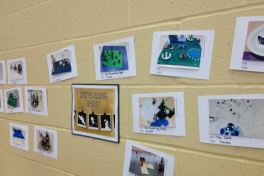 Our growing library of stories
Our growing library of stories Behind the Scenes: We decided to bring a mini photo printer to the Pop-Up so children could take photos of their creations home with them. Providing an artifact with which to retell their stories was our way of meeting the 2014 Literacy Day challenge of “15 minutes of literacy with your family.” We spent some time deciding whether or not to provide a template for the photos. The design of the template went through various iterations until we boiled it down to a very simple layout with space on the front for the title and the author. We printed two versions – one with lines on the back and one without – imagining the children would self-differentiate (which they did). We discovered that the children who regularly enjoy writing asked for the lined version and easily gave their stories titles. These children were as passionate about writing as they were about building their stories. Others were happy to take their photos home – untitled – eager to practice their oral language skills by sharing their stories with family and friends.
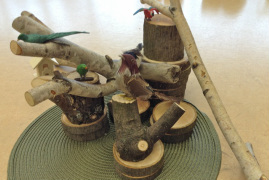 A story that just kept growing
A story that just kept growing An 11-year old boy who built five incredibly intricate stories, was reluctant to write them down or share them verbally. However, when he got home he found a way to express himself. The stories he shared with his family were not about the content of what he had created but about how he had built each story and how the experience had made him feel. He described his selection and building process – which is storytelling in a different way, but storytelling all the same. Another child who struggles with writing assignments and often complains that she hates writing, was given a homework assignment to write a journal entry about her weekend. That night she confidently announced: “No problem, I know what I’m going to write about” and proceeded to fill the entire page in less than 10 minutes – writing about the way it felt to participate in the storybuilding pop-up. This child, who usually struggles with every sentence on the page, was squeezing in words right to the very last line. Experiences like these help us recognize that choice and voice in an environment that supports multiple definitions of literacy will not only help children meet learning objectives but may even encourage them to embrace writing on their own initiative.
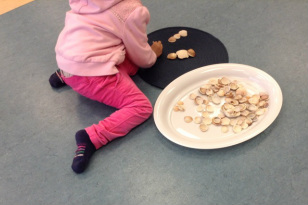 starting with shells
starting with shells The biggest Lesson from the Littlest Child: We like to think that every child who participates in our programs becomes part of our learning and future planning process. This time it was a 3-year old girl who pushed our thinkin’ forward in a really big way. She and her mother and grandmother all spoke little-to-no English, making it difficult for us to explain what was happening in the room. But this wonder-filled child was determined to participate. First she made a bee-line for a large bowl of seashells, then she scanned the room to see what the other kids were building and began walking back and forth between her work-space and the loose-parts picnic, carrying as many items as her little hands could hold. Gradually her story began to take shape. Twice she was offered large but interesting creatures from adults in the room but both times she turned them down with a dismissive wave of her hand. Finally, when her story was almost complete, she walked over to the creature buffet and carefully selected three very small, delicate animals to invite into her story. When she was done we snapped a photo of her creation, then mother and daughter chose a picture-book from our bookswap table and curled up on a chair in our snack area.
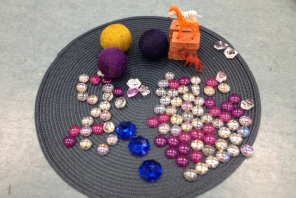 a not-so-backwards story
a not-so-backwards story Later that night as we reflected on the day’s events, we discussed the way this young child had silently built her story “backwards” and how she and her mother had so eloquently embraced our literacy day challenge. And then it dawned on us – her story-building process was only “backwards” according to our expectations. What we considered a language barrier actually freed this child from expectation. She chose for herself how to build her story, and for her, it made sense to create the scene first and then add the characters. Yet, we had given all the other children verbal instructions to choose their creatures first. As teachers and parents, we both know the dramatic effect that language can have on our children’s learning. On this day, our simple but specific instructions determined the order in which the rest of the children built their stories. Rather than asking them to choose a creature first, then build a story around it, we could have said: “choose a creature and some materials to build a story.” This slight change in our verbal provocation would have given every child in the room the power to choose their own point of entry for their storybuilding.
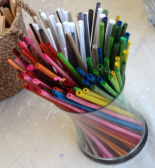 Who knew?!
Who knew?! Not Far Enough: We then thought back even further to our initial planning stage – to our first idea of assigning creatures randomly to the children (surprise! challenge!) Then to our second idea of having them pull hidden creatures out of a bag (sensory! choice!) Eventually we settled on creating a buffet of inviting creatures that would inspire the children to build their own stories. It never occurred to us that the materials for the setting of the story might provoke their creativity more than the characters. We were convinced we had undone the structure of storytelling as far as it could go and then discovered we hadn’t gone far enough.
We can’t believe how easy it was to fall into the trap of giving very specific instructions so that every child would meet the same learning goal. Even with all of our planning there is always room for improvement. We've learned that using specific instructions may seem like it will create an easier outcome but the end result is actually more complex. When we ask a group of children to follow a narrow path that’s been set out for them, we can end up with some students who meet the success criteria, but also many discouraged learners who do not. When we spend the bulk of our energy on front-end purposeful planning, we reduce our time and energy on the back-end by creating a wider path for students to navigate their learning more smoothly. Click here to see more images from our Storybuilding Pop-Up!
We can’t believe how easy it was to fall into the trap of giving very specific instructions so that every child would meet the same learning goal. Even with all of our planning there is always room for improvement. We've learned that using specific instructions may seem like it will create an easier outcome but the end result is actually more complex. When we ask a group of children to follow a narrow path that’s been set out for them, we can end up with some students who meet the success criteria, but also many discouraged learners who do not. When we spend the bulk of our energy on front-end purposeful planning, we reduce our time and energy on the back-end by creating a wider path for students to navigate their learning more smoothly. Click here to see more images from our Storybuilding Pop-Up!

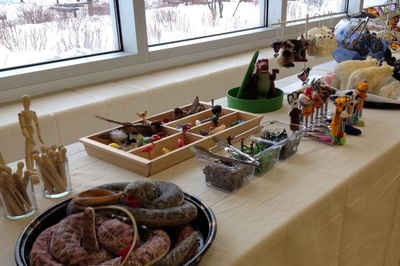
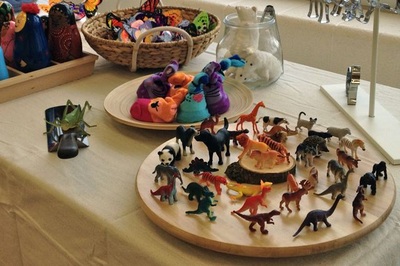
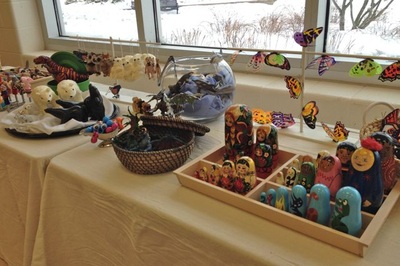
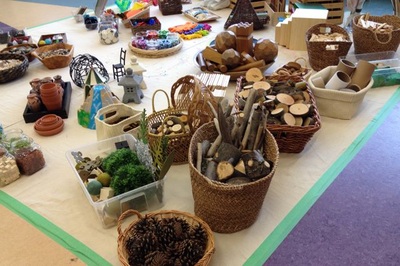
 RSS Feed
RSS Feed



